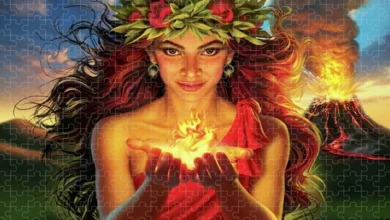Samburu tribe: either Lokop or Loikop, Samburu means “butterfly”
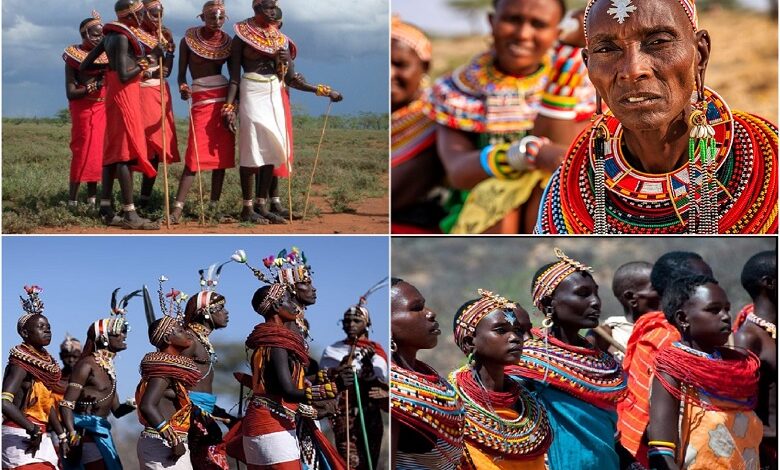
The closest relatives of the famous Maasai are the nomadic Samburu tribe. They live in the north and central regions of Kenya. Their main occupation is animal husbandry, so they force to roam searching for fresh pastures for their livestock.
All vain attempts to move to a more comfortable – sedentary lifestyle hurt their self-sufficiency and ability to preserve their traditional values and centuries-old experience carefully.
Proud nomad breeders
The tribe finally form in 1840 after the separation from the Maasai people. It settled along with the scenic Ndoto mountain ranges in northern Kenya. These places have not yet been touched by civilization. Samburu deliberately does not make contact with the modern world (although they are pretty benevolent) in the name of preserving their traditions.
Unlike the Maasai, Samburu are genuinely devoted to their age-old traditions: they are cautious about numerous customs and still unquestioningly hold ancient ceremonies. Having chosen this development path, Samburu does not have pronounced conflicts with their neighbors and consider themselves proud enough to look for ways to “modernize”.
Every 5-6 weeks, several families unite and go in search of new pastures for livestock. They set up a camp there and only then drive the herds. Samburu is raised mainly for bulls, cows, sheep, goats, and camels.
Dwelling Samburu made of twigs
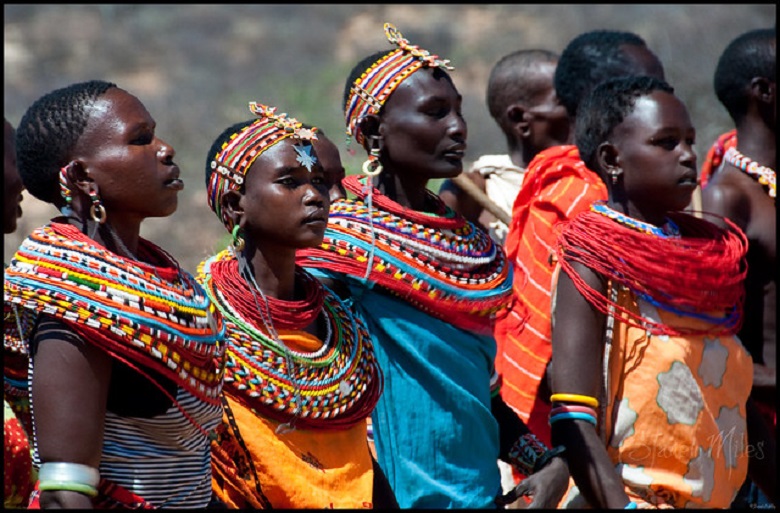
The national dwellings of the Samburu, the Manyattas, are made of clay and skins. Inside, hammocks made of grass and straw used as sleeping places. The advantage of such houses is their fast transportability. They can quickly disassemble and reassembled if required. A barbed fence usually surrounds the camp to protect it from wild animals. The wall also consists of a kind of removable sections.
Appearance
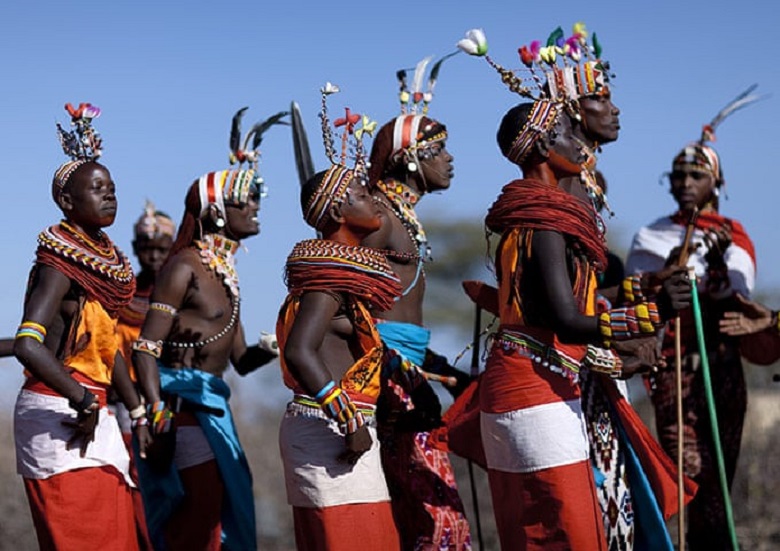
Due to inter-tribal marriages with the Turkana, Rendille, and Borana peoples, the appearance of Samburu is quite different from the rest.
Perhaps the similarities between these African tribes are dark skin color, black hair, and lean physique. In the language of neighboring African tribes – Samburu means “butterfly”. Most likely, this tribe got this name due to clothes of bright colors and multi-colored jewelry. Fabrics of bright color, more often pink, yellow and red, Samburu is thrown over the shoulders or tied at the waist like a long skirt. This traditional outfit is called Shuka.
In everyday life, Samburu men and women can walk topless or wear a loincloth. Sometimes it is decorated with intricate and vivid ornamentation. Before the advent of full-length clothing, Samburu wore animal skins. Nowadays, only women use pieces of leather as aprons. The skins use in ceremonies.
A lot of beads are an essential part of the Samburu’s appearance. They are woven with a complex pattern and laid around the neck in multi-layered ornaments that can speak volumes. For example, to be a symbol of power, the difference from each other social groups, or to communicate that its owner has the ability to witchcraft. And yet, their inherent feature is aesthetic beauty.
The men of the tribe devote a lot of time to their hairstyles. They have braided their hair in braids since their youth and shaving it off when they reach a respectable age. Such braids are a symbol of masculine beauty and masculinity. But women, on the contrary, shave their hair.
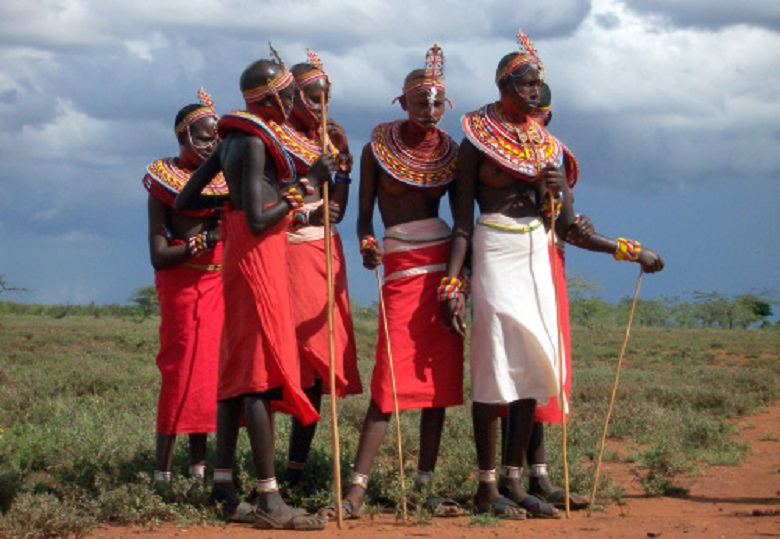
Smooth skull structure and smooth skin on a shaved head are the standards of female beauty. Samburu hair dyed with ochre gives them a golden-red hue and protects them from overheating.
Family life and everyday life
Samburu live in small groups of 5-10 families—a clear division of labor reigns in each settlement. Men are engaged in the most important business for Samburu – grazing livestock, which is their main livelihood. Women are, in turn, responsible for a standard set of household chores: preparing meals, growing and collecting roots and vegetables, milking cows and goats, bringing water to camp, collecting firewood, and caring for the children. They also provide general order and stability to the tribe. The responsibilities of little boys and girls who help parents are similarly delineated.
Everybody dance
One of the most critical places in the culture of this people and throughout Africa belongs to dancing. Although Samburu loves to sing and dance, they traditionally do not use instruments to extract music, not even primitive drums. They have danced for all occasions. The most famous of them, oddly enough, is timed to the beginning of military conflicts.
Traditional men’s dances include high jump – they are a trendy sport here. To become a good dancer requires severe physical training, so such dances also demonstrate the strength of warriors. Most collective dances involve both men and women. Usually, they lead separate round dances, performing specific dance moves characteristic of each gender. At the same time, the movements of round dances have their own strict rules.
Samburu has another type of dance that perform by single youths and unmarried girls. Young people “circle” around the girls and, from time to time, as usual, jump up, showing their red braids to the girl they like. So they ask her out on a date!
Traditional food: blood with milk
The most crucial product without which Samburu could not exist is milk. From time immemorial, it has been the staple food of these people. It is usually drunk fresh or sour. Beef is rarely eaten, usually only in ceremonies. Cows never kill on purpose but wait until the animal dies by itself. The meat of smaller animals consumes much more often, although also irregularly. The echoes of civilization still reach Samburu, and lately, they are increasingly beginning to use the money they usually use to buy corn flour for cooking porridge.
The most common drink is tea. It is typically drunk with a lot of sugar and milk. Remarkable is the fact that tea prepared in this way is considered food! But the most surprising thing for us, and quite common for African peoples, is that they consume animal blood for food. It regards as an utterly complete food product, and many dishes prepare from it.
Religion
Samburu are monotheistic shamanists. They worship Goddess Nkai. She is associated with the sky and rain; she is the protector. But the goddess can get angry and punish the young man at the will of the elders, for example, for lack of respect. In this case, you should beg her for forgiveness and offer a gift. Children and young people, especially females, sometimes report that they see the goddess – such is the power of the supreme deity over Samburu.
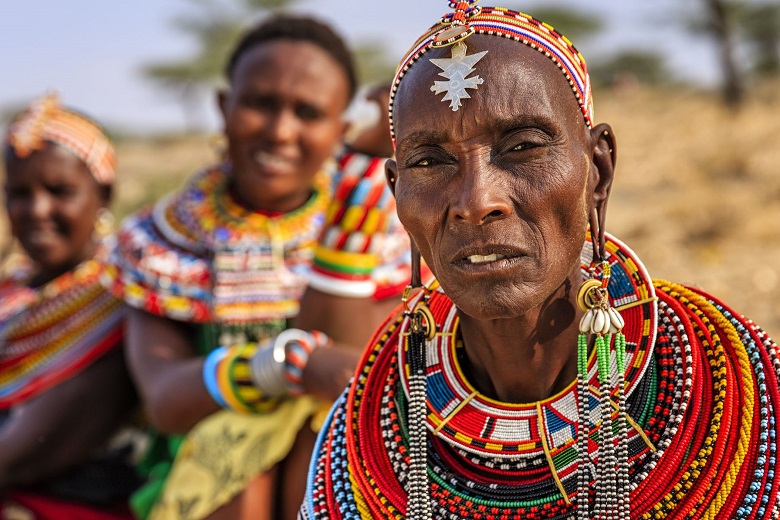
Nkai supposedly lives on mountain tops, in the crowns of large trees, caves, or springs. Older people are preparing for death’s dream of being buried facing the majestic mountain where Nkai lives. The tribes also have shamans and soothsayers. The first, according to Samburu, treat diseases and help warriors in battles. And the second – predict the future and, with the help of mysterious spells, ask that good prophecies come true.
The tribe generally accepts the worship of the spirits of ancestors and witchcraft. Samburu believes in magic spells and performs traditional rituals to increase fertility, protect against animal attacks, heal, and other needs.
Tribal traditions
Wedding traditions
Only elders can marry Samburu. They are allowed to have several wives at once. The only condition is that for this, the groom must be a wealthy person. For each bride, he must pay a ransom. Most often, cows act as ransom.
The Samburu wedding ceremony is a complex system of unique rituals. Great importance is attached to the groom’s gifts (usually goat skins, copper earrings, homemade pumpkin dishes, etc.). The crown of the ceremony is the killing of the bull. The bride’s mother directs him to the groom’s hut, and there the bull is to be killed in commemoration of the conclusion of a new blessed union.
The bride gives her consent in a very “democratic” way – she will not enter the groom’s house until she has received as many cows as she wants. If she suddenly has something out of spirits, she can go back to her father’s house, and then the wedding will be considered invalid.
After the marriage and the birth of children, each woman gets her own home. Procreation is a cornerstone in the life of the Samburu tribe. Sometimes women who cannot have children are ridiculed and bullied.
Initiation
The initiation ceremony for boys is performed at the age of 14 and always celebrate in a big way. Having passed this traditional rite, the boy becomes a male warrior, i.e., “Murran.” At the age of 28, this status changes to that of an elder. Girls are married early, starting at about ten years of age. The position of a married woman changes for the better as children are born.
Council of Elders
Male elders govern the tribe. They make general decisions at special meetings. Typically, elders gather under a tree that marks the meeting place. Women can also take part in discussions. They usually sit in the outer circle and comment on specific statements or convey their wishes through male relatives. Also, women can set up their meetings and then report their appointments to the men’s council of elders.



